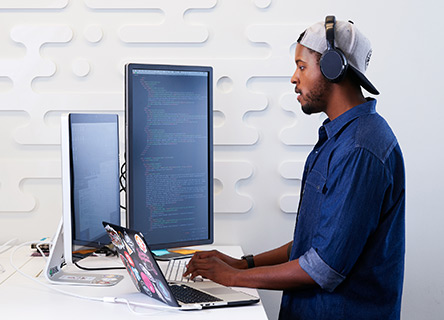Corporate Citizenship
94,000 frog calls and counting: How crowd-sourced science could help heal the planet
January 15, 2020
Categorized: Corporate Citizenship
Share this post:
Author: Justine Jablonska, Content Director, IBM Industries
Godzilla’s dark eyes are deeply set atop his head, giving him near 180° vision. His skin is a bright green. He loves eating insects and is a skilful climber. And like all Australian Tree Frogs, Godzilla has a distinctive croak: an earthy bark somewhere between a seal’s and a puppy’s.
Godzilla is the face of the Australian Museum’s FrogID project, a citizen science project launched in 2017. The goal: find out where the frogs are and what habitat they breed in, and use that data to see which frogs may be at risk, and where. It’s an ambitious undertaking made possible through the world’s first smartphone app designed in partnership with IBM to record and report frog calls without disturbing the creatures. A call is one of the most accurate ways to identify frogs, so that’s what the app records, along with recording date, time, and GPS location.
Bettina Cutler, IBM’s Citizenship Manager for FrogID, was part of the team that worked with the museum on the app—including testing it in the environment it’s now used.
“We went on a field trip out in the bush,” she said. “All the developers were very excited. During the day, we scouted for spots where frogs might be found.”
They returned to test the app at night when the nocturnal amphibians are at their froggiest: croaking, barking, whistling, chirping. The development team gave careful consideration to preserving the environment in the app’s design, so the app screens are dark for the least intrusion possible. Why frogs? They’re at a tipping point in the environment and an important indicator of the health of their surrounding habitats, according to Jodi Rowley, the Australian Museum’s Curator of Amphibian & Reptile Conservation Biology.
How are you engaging your citizens?

Dr Jodi Rowley with Godzilla at the Australian Museum FrogID launch in November 2017
Dr Rowley has discovered 26 frog species in Australia and Asia. She estimates the project will help conserve Australia’s 240 native frog species, their surroundings—and perhaps even discover new species. She and her team listen to all the calls received via the app.
Environmental consciousness is an important part of Frog ID. “When you go for a walk and are listening for frogs, you become more conscious about the environment,” said Cutler. “That’s something we’re trying to instil in people.”

Litoria raniformis | Southern Bell Frog
The project includes a school program that teachers can use in their STEM lessons but isn’t limited to children.
“It appeals to all ages,” Cutler said. “So many people are involved.”
Sally Patterson, an avid FrogID app user, lives on a farm in South West Australia where she raises sheep and grows crops. Her favourite hobby is photographing wildlife on her property.
“I developed a passion for Southern Bell Frogs after finding some in the dogs’ water dishes during a very dry summer years ago,” she said in an email. “When I discovered they were endangered, I decided to build a pond for them in the garden.”
Three years later, the pond is also home to Brown Tree Frogs, which, she said, have “bred in abundance.” Patterson first focused on recording the frogs in that pond, and then on various dams on her property. She continues to extend her radius, taking back roads on her 40-minute drive to the nearest supermarket.
“I now drive more slowly with the window down, and if I hear frogs, I’ll stop and do a quick recording,” she said. “Takes me a bit longer, but worth it!”

Pseudophryne australis | Red-crowned Toadlet
In addition to the Southern Bell and Brown Tree Frogs, she’s recorded Eastern Banjo Frogs and Striped Marsh Frogs, among others. Patterson is proud of what she calls her “small contribution to science.” She’s concerned about the impact of humans on the planet and credits the app with learning about various environmental issues.
Another FrogID enthusiast, Roxanne Herson, lives in Sydney’s Upper North Shore, on the edge of Garigal National Park. She’s learned a lot from the app (“nicely surprised by the frog pictures and details,” she wrote) but has yet to record her resident frogs.
“I have caught them watching me through the bi-fold doors going out onto the patio, but they must have a sixth sense when I bring out my phone as they stop calling,” she said.
She remains optimistic, however, and has promised to share when she does record her first frog.
Since FrogID’s launch, users have found 193 species and 141,759 frogs have been verified. The goal for the project’s entirety of five years is 200,000 frog recordings. According to Dr Rowley, they’re well on their way to exceed that target. Other targets include a number of species, number of repeat recordings from places, and ensuring that calls are received from each species across Australia.

Litoria raniformis map
University of Maryland biology professor Dr Karen R. Lips is impressed with the speed at which the project is gathering data.
“We have plenty of experts, but the chance to go out into the field is limited,” she said in a phone interview.
Crowd-sourcing gathers massive amounts of data in short amounts of time with limited resources. One scientist in a lab might spend a lifetime gathering that amount of data. The Australian Museum is creating maps in real-time from the data, so its scientists will be able to analyse the data much earlier thanks to the immense crowd-sourcing. That, Dr.Lips said, will lead to great conservation decisions thanks to the huge amount of data.
“It’s great biology,” Dr Lips said. Dane Trembath has lived in Australia’s Northern Territory for more than 20 years and is part of the team that helps Dr Rowley identify frog calls. He’s excited about the data being collected.
“By knowing where frogs live and breed, the Australian government will be able to make important decisions,” he said. “Without that data, bad decisions could be made that cannot be reversed.”
How IBM is helping to skill South Australian students for the jobs of the future
By Jade Moffat Herman, Corporate Social Responsibility Lead, IBM A/NZ After almost seven years at IBM Australia and New Zealand, you don’t need to tell me how rewarding a career in technology can be. In my role as Corporate Social Responsibility Lead, I am honoured to work closely with leading public sector, not-for-profit and educational […]
Four Australian teams lead the 2021 Call for Code to help combat climate change
By Alison Haire, Lead Developer Advocate, Hybrid Cloud Build Team Solving global challenges like climate change may seem never-ending, but we can draw inspiration and hope from communities that are making a difference. The open-source movement is one such community, involving hundreds of thousands of individuals and organisations around the world. Together, they have created […]
How to avoid data breaches while accelerating your digital transformation
Author: Chris Hockings, Chief Technology Officer (Cyber Security), IBM Australia and New Zealand As the pandemic accelerated your need for digital transformation, you needed to act. And fast. And you were not alone. But new findings from the recent IBM-Ponemon Institute Cost of a Data Breach Report 2021 suggest that an organisation’s pace of change […]


